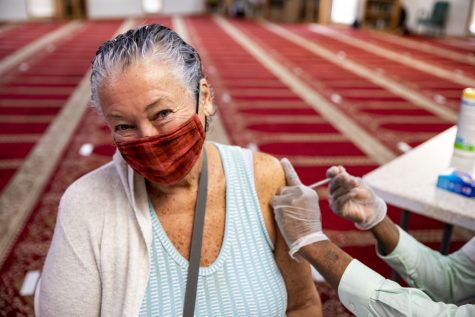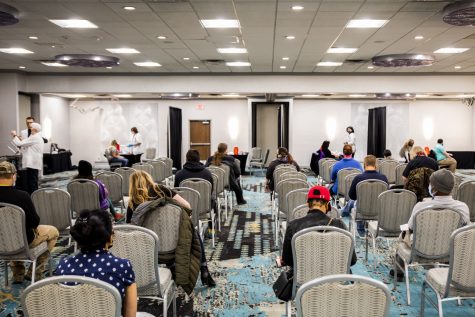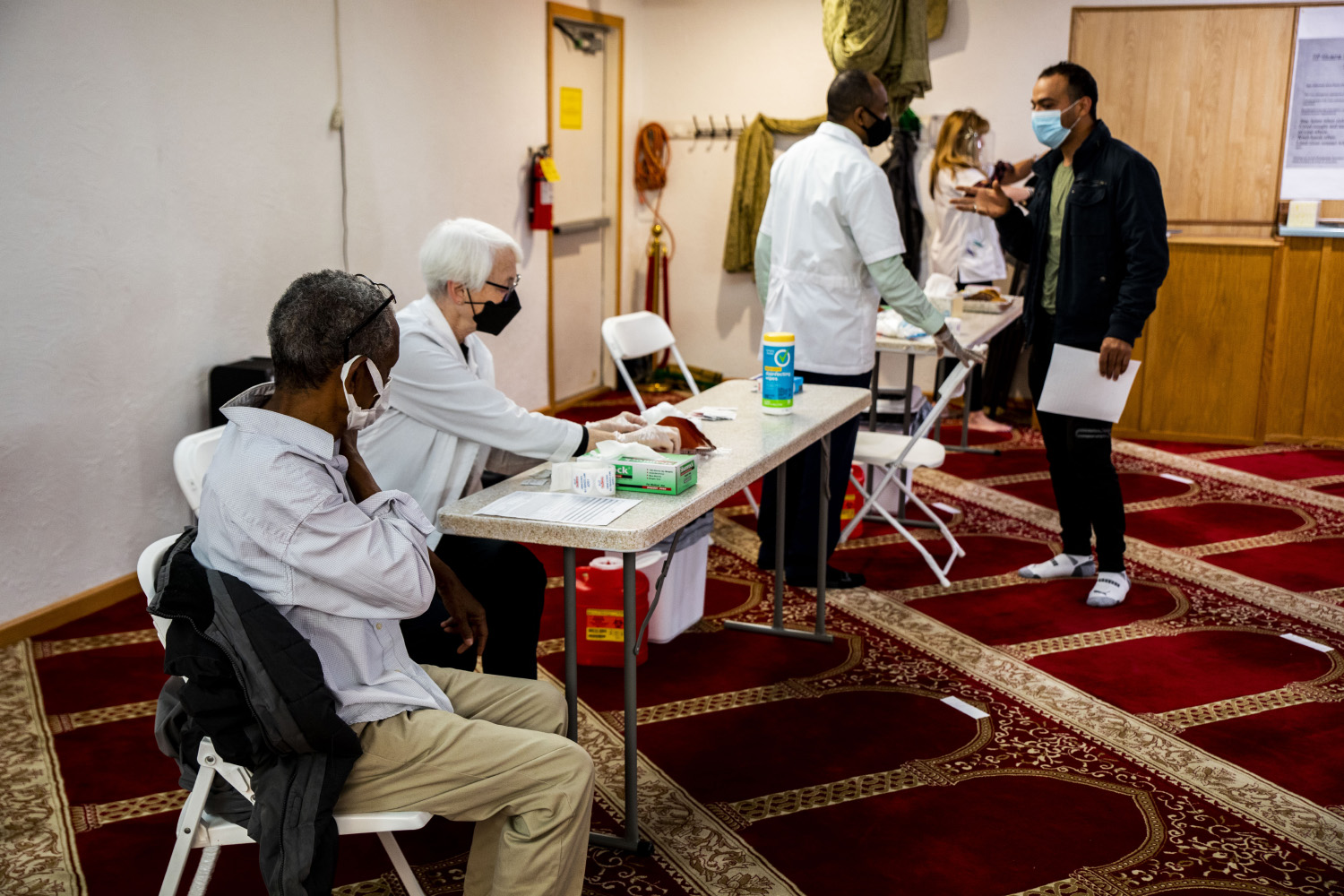How independent pharmacies have stepped up to provide vaccination over the past year
Over the past year, local pharmacies have become pillars of strength in their communities, providing necessary services and vaccinations in the middle of the COVID-19 pandemic.
April 18, 2021
There is an expected sense of organization within one of the most widespread vaccination efforts in decades. Bright colored masks, the sharp smell of antiseptic, rigid social distancing, and cheery blue and red stickers proudly declaring, I Got My Covid-19 Vaccine! are all an expected part of the process at Hartig Pharmacy.
What is less expected is where vaccinations are administered.
Charles Hartig, CEO and owner of Hartig Drug, left his pharmacy with his personal protective equipment and 30 doses of COVID-19 vaccine three weeks ago. His destination was St. John’s Lutheran Church in Dubuque, a church that serves a homeless population that includes a contingent of LGBTQ youth.
Hartig administered the 30 vaccinations by himself to various members of the church; many of which, Hartig said, told him that they believed it would be months before they would have the opportunity to be vaccinated.
“It was a group of patients who thought that they would probably be marginalized and never able to get a shot and fall through the cracks,” Hartig said.
Those cracks that leave open vulnerable areas of local communities are areas that community pharmacies and volunteers are working to combat. Hartig Drug, which has 15 locations in Iowa and five in Wisconsin and Illinois, is one of the hundreds of independent pharmacies that serve community and rural locations.
And, in the wake of a pandemic that has exposed vulnerable gaps in communities, it is not uncommon for local pharmacists to go to the people who need vaccines the most.
These off-site clinics can serve groups of as few as five people to as many as 400, and have included teachers, people 65 and older, casino workers, and people who are homeless. On average, clinic workers administer 500 to 600 doses at these off-site locations any given week, in addition to the doses they provide at their pharmacies.
This trend is not limited to Hartig. All over Iowa, dozens of pharmacies including Towncrest Pharmacy and Reutzel Pharmacy, are leaving their pharmacies, and entering their communities, educating and vaccinating in addition to their usual services.
But the road to vaccination was not always easy for these local pharmacies, and reaching the positions they are in now was a hard-wrought battle.
Beginning the Process
One of the biggest challenges for Randy McDonough, co-owner of Towncrest Pharmacy located in Iowa City, was restructuring his practice at the beginning of the pandemic.
Gone were the days when customers and patients could come and go as they pleased. For the first three months of the pandemic, the lobby was closed. Curbside and home delivery began to take precedence, and even once the lobby reopened, there were added reminders of the reach of the pandemic.
“Everything became very systemized and process-oriented to ensure that we were keeping people safe,” McDonough said. “We never shut down. We never reduced our hours. We still had to deal with the drug shortages that appeared periodically during the pandemic, but otherwise, it was full service, just offered in a different way.”
McDonough said that, when he was witnessing COVID-19 cases spill out of hospitals and saturate communities in New York at the pandemic’s beginning in March 2020, he reached out to a group that was overseen by the Emergency Management Agency to conduct weekly calls about the status of Johnson County.
Throughout the next few months, McDonough offered his insight into community-based pharmacies and emphasized during calls to the group about the importance of their work, knowing that community pharmacies could have a massive role to play once vaccinations began.
According to the Pharmaceutical Care Management Association, there are 23,061 independent pharmacies across the U.S. compared to 39,084 chain pharmacy locations, as of 2019. A massive portion of the population will turn to community pharmacies for vaccines, especially in more rural areas that do not have the same access to bigger chain pharmacies.

McDonough is also the director of practice transformation for Flip the Pharmacy, an organization which works at more than 900 pharmacies nationally to change community practices to focus more on long-term patient care.
He urged other local pharmacists to start making connections. To best serve their communities, McDonough said, bigger health departments needed to know who people at the pharmacies were.
“Just let them know that you are a solution,” McDonough said. “Keep saying that you are a provider that’s ready. You’ve got the systems in place; you know about the workflow and reporting and the paperwork that needs to be done. [We] can do this.”
Ensuring larger organizations knew local pharmacies could be a solution was a challenge that Mitch Myers, pharmacy manager of Reutzel Pharmacy in Cedar Rapids, echoed.
Myers stated that resources are more challenging for local pharmacies that do not have the same strength of voice that larger pharmacies, such as CVS, do. Even before the vaccine rollout began, Reutzel Pharmacy struggled to ensure that it received the allocation needed for gowns, gloves, needles, and syringes without the same order history as larger corporations.
“We’re all trying to figure out how to do this,” Myers said. “Whereas larger corporations may have entire teams dedicated to this … it’s myself and a couple of staff members here.”
Starting to vaccinate
The first rollouts of the Pfizer and Moderna vaccines began in December 2020 and both Hartig Drug and Towncrest Pharmacy were asked by the county to start providing vaccinations by the end of the month. Notably, Reutzel Pharmacy was not, and the staff was left waiting for answers.
“The counties were as transparent as they could be and they were doing a lot of work,” Myers said. “But it is confusing, sometimes, to see other counties so far ahead or behind us.”
One of the areas both Myers and McDonough cited as a source of frustration was the lack of communication between public health organizations and pharmacies. For each pharmacy, there are multiple sources of allotment for vaccinations, ranging from the county public health departments to the Federal Pharmacy Partner Program.
Often, smaller pharmacies are overlooked by these organizations. According to a survey by the National Community Pharmacists Association, nearly half of independent pharmacists across the U.S. are not getting enough, or any, doses of the COVID-19 vaccine to give to their patients. Of those surveyed, 47 percent reported serving populations with a significant minority population.
While Towncrest and Hartig Drug were able to receive vaccinations through Johnson County Public Health, they, like Reutzel Pharmacy, were not yet allotted vaccinations by the Federal Pharmacy Partner Program at the start of the vaccination rollout.
Still, with the first vaccines in hand and a population waiting, Hartig Drug and Towncrest Pharmacy began to tackle the challenge of ensuring a smooth, safe rollout.
A specialized freezer to store the Pfizer vaccine was purchased out of pocket by Towncrest Pharmacy. Online registration for eligible members of the population opened, resulting in long waiting lists, and causing an unexpected trigger effect — call volume and emails.
“It made me understand how urgently people wanted the vaccine,” McDonough said. “I felt bad that we couldn’t open it up more but, when we get the allocation, it is based around the number of people we’re getting it for … It’s not as easy as going in as saying, ‘Hey, I want my flu shot.’ There’s not an allocation problem there.”
Hartig also underestimated the need for communication and demand far outstripping supply, and calls and emails to the pharmacy compounded, which was something he never anticipated a year prior.
“The failure to communicate with people directly is really falling on the providers,” Hartig said. “There was more time spent fielding calls and concerns from patients and determining eligibility than actually giving out vaccines and reporting vaccines that were administered.”
With the excess demand, local pharmacies also found themselves facing a second, vital challenge. A large portion of the population in the first phase included older people, who may be non-digital natives and less likely to have the same access to technology to find online vaccination appointments.
Thus, the pharmacies had to take a dual approach to spread the word about vaccines. They educated on social media platforms and advocated through non-broadband avenues such as print advertising, signs, and direct calls.
And, as the vaccination efforts began within the pharmacy itself, so did the outreach in communities with off-site clinics, including senior homes and the workplaces of essential workers. Volunteers stepped up to assist the pharmacies and by extension, their communities.
“It’s amazing to me the number of people coming out to volunteer their time and efforts to make this happen,” McDonough said. “We’re part of a community. And this is our way we can help the community, but we have a lot of community members offering their time and talents to help make sure it’s successful.”
With the help of volunteers, several pharmacies were able to take on bigger off-site clinics and, as the rollout continued, the experiences they gained in the first phase assisted them as they broached the opening of the vaccine eligibility to the general public.
Open to all
Hartig Drug, Towncrest Pharmacy, and Reutzel Pharmacy were all activated by the Federal Pharmacy Partner Program in March. Vaccinations opened to all adults in Iowa over the age of 18 on April 5.
With the eligibility opening came an outcry of support for local pharmacists, including touching responses from their patients.
Each pharmacist described the general reactions of their patients as joyous, excited, and often emotional, with an outpouring of gratitude for everything that pharmacists are doing. In one case, McDonough even received flowers from a grateful patient.
“It’s probably one of the most satisfying things I have done in my career, ” McDonough said. “Knowing that you are helping people get back to some kind of normalcy and be able to see their loved ones again is a pretty good feeling to have.”
While Myers said he was uncertain why his pharmacy was not activated sooner, he guessed it had to do with the chaos caused by preparing to vaccinate 3 million Iowans. Since Reutzel’s activation, communication with the county health department has improved drastically.
“Working with the county over the past couple of weeks, I think we all started to realize how much of a scramble it is to get those shots going for everybody,” Myers said. “They were definitely trying to do their best, but I think some [pharmacies] may have fallen through the cracks, and we just happened to be one of them.”
As for the vaccination process itself, the past few months have allowed pharmacists to streamline the process for patients as much as possible. Hartig noted that “off-site” clinics can take several days to plan and ensure they have enough volunteers, a space that allows for social distancing, and designated waiting areas.

In general, Hartig described the process as fairly straightforward and systematic. A patient will sign up for a time slot online and come into the pharmacy or off-site location. After presenting their information at the sign-in desk, patients will stay in a waiting room, monitored by volunteers or employees until it is their turn to be vaccinated.
Once they receive their shot, they are required to wait the allotted 15 minutes in a designated monitoring area to ensure the patient has no adverse reaction.
Behind the scenes, however, one of the challenges is ensuring that vaccinations are not wasted. McDonough explained that, now vaccines are more widely available, there will occasionally be cases where patients who signed up for an appointment won’t show up, having gotten their vaccine elsewhere or otherwise not arrived for their appointment.
Once prepared for use, vaccines only last six hours. So, when faced with the possibility of wasting vaccines instead of getting them into the arms of patients, Towncrest decided to post messages on social media at the end of each day, stating how many vaccines they have left and allowing community members to take those remaining shots.
“We are very proud to say that, as we approach 8,000 vaccines, we haven’t wasted one yet,” McDonough said.
Moving On
As vaccinations continue to roll out around the state and country, new challenges and opportunities still begin to face these pharmacies. One such challenge is the rise of vaccine hesitancy, in which a patient delays or refuses vaccination, despite a provider having the supply to do it.
As Hartig says, demand for vaccination will slowly begin to decline as people who want the vaccine get their shot(s). While he hasn’t seen any cases of vaccine hesitancy yet, he expects to within the next few weeks.
“Most people who have wanted a shot in these smaller communities have gotten one, and now we’re at a point where we’re advocating and educating and trying to convince folks to get that shot,” Hartig said.
According to a March poll conducted by the Des Moines Register, 27 percent of Iowa adults say they don’t plan to receive the vaccine and 5 percent state they are unsure whether they want to seek it out.
While a third of Iowa adults received the vaccination by mid-March according to the Centers for Disease Control and Prevention, experts estimate that anywhere from 70 to 90 percent of the population must be immune to reach herd immunity, which is when a population is resistant to spread of a disease because of high rates of vaccination or infection.
As demand for vaccination services will begin to decline as Americans receive their vaccinations, key areas of both pharmacy and the community have been forever impacted by the wake of such a widespread vaccination effort.
One of these areas is communication, where structures and channels of dialogue that didn’t exist before the pandemic now do. McDonough said that open channel of dialogue is one of the most priceless takeaways of the pandemic.
But most importantly to these pharmacists, what has kept them going through the stress and darkness is knowing they could be a vital cog in reaching an end to the pandemic.
“I’m hopeful that the pandemic will highlight and show that community pharmacies and brick-and-mortar pharmacies are necessary,” McDonough said. “I’m pretty proud of our profession.”
